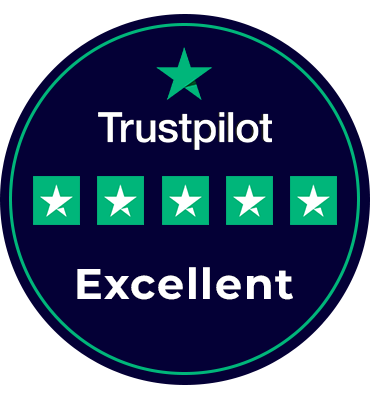9 Effective Legacy Application Modernization Strategies
Manish Kumawat
Last Updated on: 09 July 2025
Watch around the demand for modernizing platforms is increasing, and Enterprises are increasingly exploring legacy application modernization strategies to become the leader in the market. In a scenario where legacy application modernization became the fuel of business success, following the right legacy application modernization strategies is a must.
In a recent survey, 94% of surveyed businesses are actively modernizing. This shows the importance of application modernization. At the same time, think one more thing: when every business is in the legacy app modernization process, even your competitors also. What if you hold a similar strategy or a weak strategy compared to them?
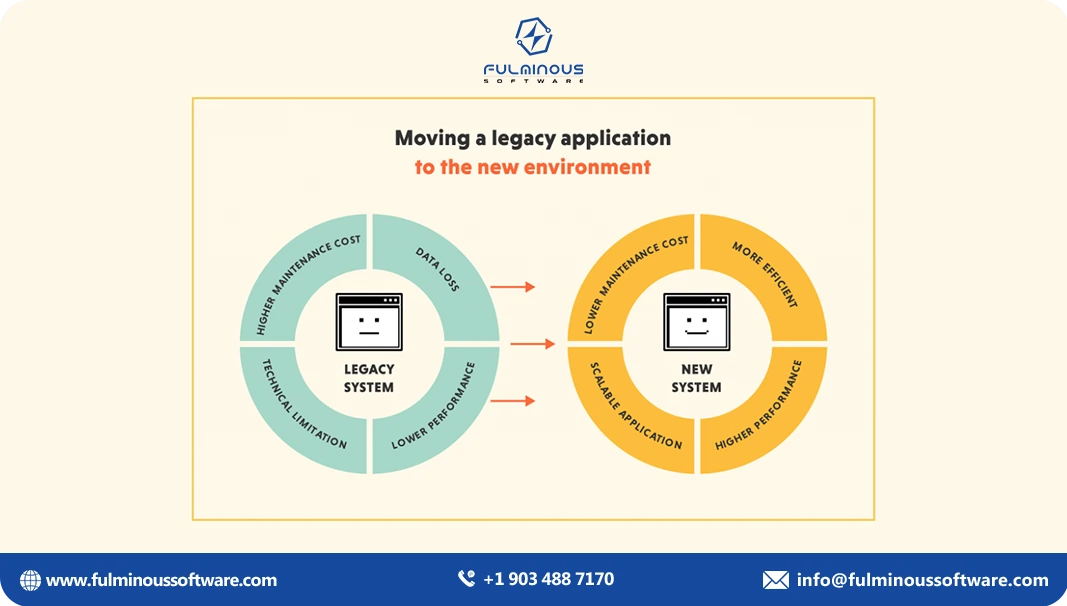
Here comes the importance of unique legacy application modernization strategies. Not only that these strategies bring several benefits for your business. Here we will see 9 proven legacy application modernization strategies and how to create a Legacy Application Modernization Roadmap. Yes, the Strategy for your business success.
Table of Contents
- 1. Why Modernize Legacy Applications?
- 2. Importance of Legacy Application Modernization Strategies
- 3. Who Can Help You Craft a Custom Legacy Application Modernization Strategy?
- 4. 9 Proven Legacy Application Modernization Strategies
- 5. Crafting a Legacy Application Modernization Roadmap
- 6. Get Custom Legacy App Modernization Strategies from Fulminous Software
- 7. Conclusion
- 8. FAQs
Why Modernize Legacy Applications?
You know, legacy applications often run on outdated code, platforms, or architectures. Consider yourself what will be your feeling when you are using such an app with slow speed, boring design, and inappropriate features? Such apps are a threat to your business’s growth.
By modernizing your legacy app, you can:
- Enhance security by replacing outdated code.
- Increase scalability to support growing user demands.
- Enable cloud integration for better accessibility.
- Reduce maintenance costs by eliminating dependencies.
- Improve user experience with modern interfaces.
- Ensure compliance with current industry regulations.
- Support innovation by integrating with modern tools.
No doubt, it's a wise decision to modernize your legacy app with advanced technologies. Then comes the question of how to. It will be discussed in the next section
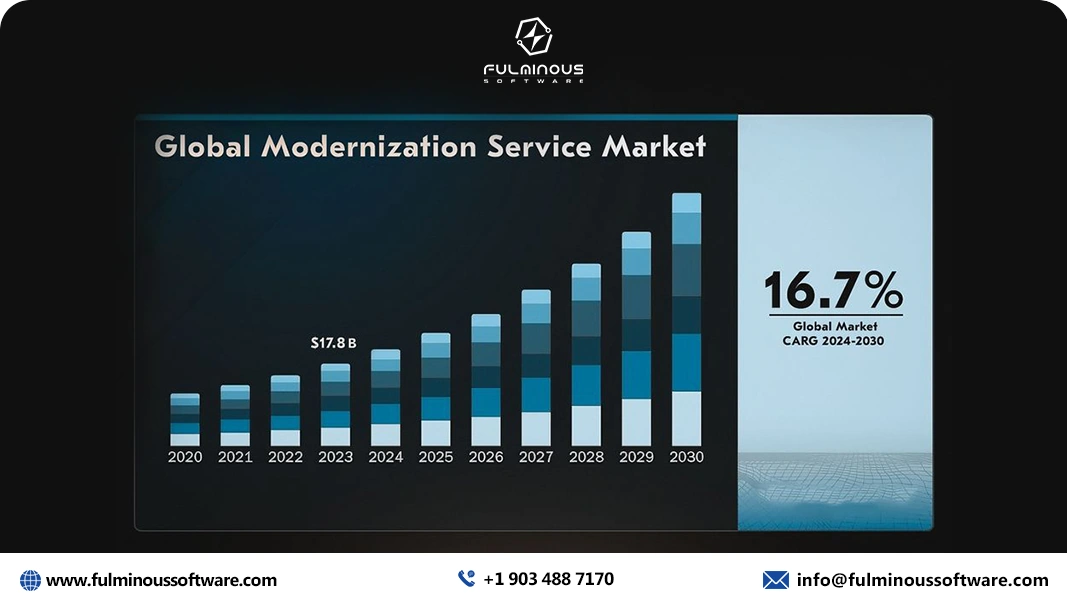
Importance of Legacy Application Modernization Strategies
Think of your are going for a holiday without a proper itinerary. Over expenses and time waste are 100% sure. Similarly, implementing the right legacy application modernization strategies is crucial. Here's why these strategies matter:
Targeted Approach Minimizes Waste
Strategies help identify which systems need a complete update vs. minor updates, avoiding unnecessary rework and costs.
Prioritized Modernization Reduces Downtime
By modernizing in phases or using hybrid models, businesses can keep operations running, saving time.
Reuse of Existing Components
Strategic planning allows the reuse of code, APIs, or architecture, cutting development time and expenses.
Faster Decision-Making with a Clear Roadmap
A well-defined strategy sets priorities and timelines, helping teams avoid delays and misdirection.
Cost Forecasting and Budget Control
Strategies outline expected costs and ROI, allowing for better budgeting and resource management.
Avoids Technical Debt Accumulation
Strategic modernization removes obsolete code in a systematic way, reducing long-term maintenance costs.
Enables Agile and DevOps Integration
Strategic planning makes it easier to adopt faster, iterative modernization methods, cutting project timelines.
Improves Vendor and Tool Selection
With a clear strategy, businesses can choose the right tech stack, avoiding costly mistakes.
Overall, you need a proper plan before you begin the actual modernization process.
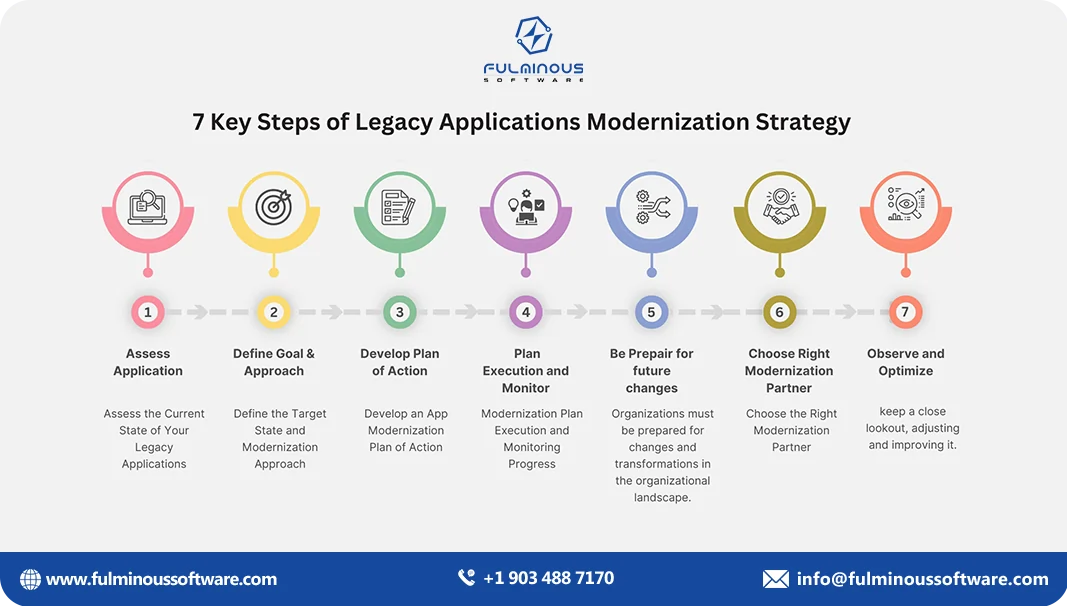
Who Can Help You Craft a Custom Legacy Application Modernization Strategy?
To build a successful legacy application modernization strategy, businesses must partner with the right Legacy application modernization company. But remember, an ordinary software company can’t assist you. You need a legacy app modernization company with quality like:
- Experience with Legacy & Modern Tech Stacks
- Proven Legacy Modernization Portfolio
- DevOps and Agile Capabilities
- Cloud and Container Expertise
- Data Migration and Integration Know-How
- Customized Solutions Provider
- Ongoing Support & Optimization
Yes, we know, it is difficult to find a legacy app modernization company with all these qualities, but we will introduce the best legacy app modernization agency in the last section of this guide.
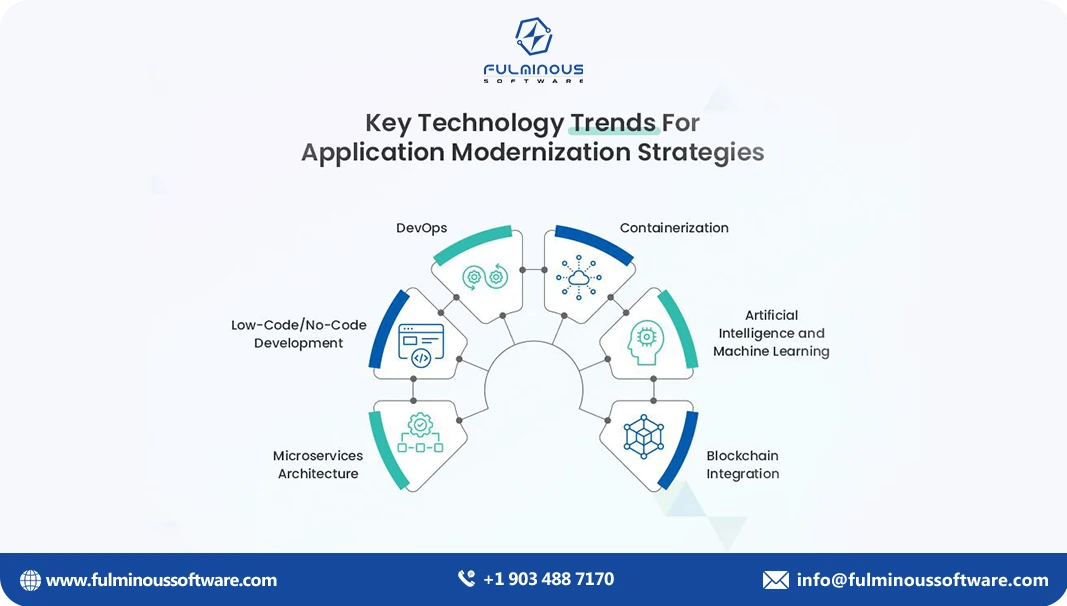
9 Proven Legacy Application Modernization Strategies
Here are the common and effective legacy app modernization strategies that can take you to the right goal.
1. Encapsulation
Encapsulation involves covering your existing legacy application in an API so it can interact with new systems. This allows you to keep the core functionality while adding new things.
- Great for: Immediate interoperability
- Pros: Low risk, faster implementation
- Cons: Doesn’t fix underlying architectural issues
- Best used for: Integrating legacy systems with modern corporate applications.
2. Rehosting (Lift and Shift)
This strategy involves migrating your application from on-premises to a cloud platform without changing its code.
- Great for: Quick wins in cloud adoption
- Pros: Minimal code change, lower infrastructure costs
- Cons: Doesn’t improve application functionality
- Use case: When you want to reduce hosting costs but keep the existing system.
3. Replatforming
In this target, a slight modification to the application is required to take advantage of modern infrastructure capabilities.
- Great for: Intermediate modernization
- Pros: Balance between effort and benefit
- Cons: Still dependent on legacy code
- Ideal for: Moving towards microservices or serverless architectures gradually.
4. Refactoring
This involves restructuring and optimizing the existing code without changing its external behavior.
- Great for: Code quality and performance
- Pros: Makes future changes easier
- Cons: Requires a deep understanding of the current code
- Often part of: Agile and DevOps strategies
5. Re-architecting
A more significant change involves altering the application’s internal architecture to better suit cloud-native or microservices environments.
- Great for: High scalability and performance
- Pros: High ROI in the long term
- Cons: Time-consuming and resource-intensive
- Crucial for: Enterprises with outdated monoliths.
6. Rebuilding
Rebuilding the application from scratch while preserving its scope and specifications using modern technologies.
- Great for: Long-term modernization goals
- Pros: Clean slate with modern best practices
- Cons: High initial cost and time
- Best when: The current system can no longer support business needs.
7. Replacing
Completely replacing the legacy system with a new off-the-shelf or SaaS solution.
- Great for: Commodity functions (e.g., CRM, ERP)
- Pros: Modern features and support
- Cons: Change management and training required
- Recommended when: There’s a modern equivalent readily available.
8. Integration-First Approach
Using APIs, ESBs, or middleware to integrate legacy systems with modern corporate applications while phasing out outdated modules gradually.
- Great for: Enterprises with complex IT ecosystems
- Pros: Ensures continuity during transformation
- Cons: Requires a robust integration strategy
- Works well with: DevOps pipelines and hybrid environments.
9. DevOps-Driven Modernization
Combining DevOps strategies for legacy application modernization with continuous integration, automated testing, and containerization.
- Great for: Ongoing evolution and faster release cycles
- Pros: Reduced time to market, better quality
- Cons: Cultural and process changes needed
- Ideal for: Organizations embracing agile and continuous delivery.
As you have seen, each strategy is unique in nature, and you have to choose the best for your business’s nature. For that, you need expert guidance who has deep knowledge of dealing with legacy app modernization in various industries. Such guidance is only available in top legacy app development agencies like Fulminous Software.
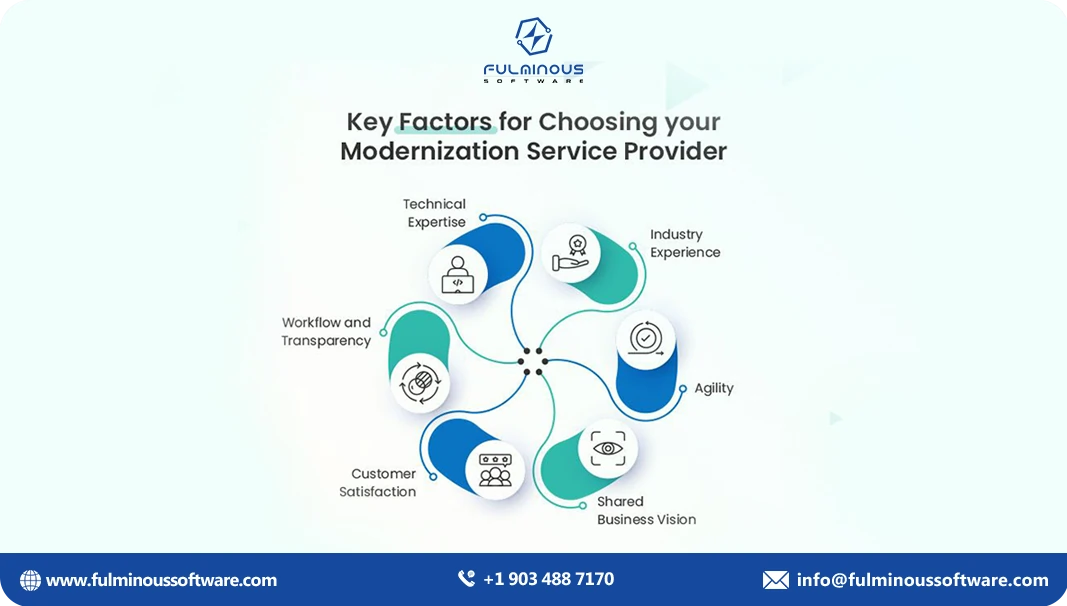
Crafting a Legacy Application Modernization Roadmap
To succeed with any legacy application modernization strategy, you need a detailed roadmap:
- Assessment – Evaluate existing systems and business goals
- Prioritization – Identify high-impact systems for early modernization
- Strategy Selection – Choose from the 9 strategies above
- Implementation – Use iterative sprints and DevOps best practices
- Monitoring & Optimization – Continuously improve and adapt
Who can help you with all these tasks? See the next section.
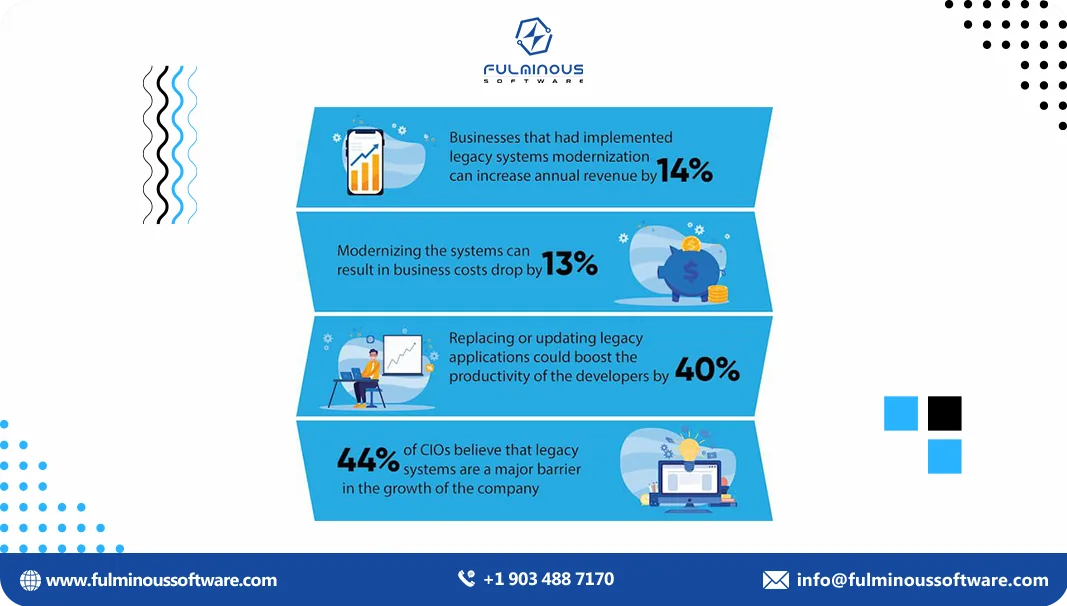
Get Custom Legacy App Modernization Strategies from Fulminous Software
Whether you need custom legacy application modernization strategies or roadmaps, Fulimous software is ideal, because we have:
Top Talent
Fulminous Software has a top-tier team building custom legacy application modernization strategies with proven success and innovation.
Trending Technologies
Fulminous Software uses trending tools to deliver scalable, secure legacy application modernization solutions across cloud, mobile, and hybrid environments.
Standard Practices
Our legacy application modernization strategy follows standard frameworks and ensures reliable, secure, and scalable transformation of outdated systems.
Long-Term Support
Fulminous Software provides ongoing support for any legacy application modernization solution, keeping it aligned with future business requirements.
Clear Communication
Fulminous Software guides you through the entire Legacy Application Modernization Roadmap with clear, collaborative, and real-time communication at every step.
Customized Strategy
Get personalized legacy application modernization strategies that support business goals and simplify integrating legacy systems with modern corporate applications.
Cross-Industry Experience
Fulminous Software brings multi-sector knowledge to every legacy application modernization solution, ensuring relevance and adaptability to your industry.
Challenge-Proven Expertise
Fulminous Software applies advanced DevOps strategies for legacy application modernization, and our teams have solved several types of challenges successfully.
Conclusion
Modernizing legacy applications needs proper planning and execution. Legacy application modernization strategies can guide your journey. By implementing the right legacy application modernization solution, you can achieve what you expect by investing in legacy app modernization. So contact us now and get the best legacy application modernization strategies made just for you! Share this article.
FAQs
Q1. What is legacy application modernization, and why is it important?
Legacy application modernization is essential for replacing outdated systems with modern technologies. Adopting effective legacy application modernization strategies helps improve performance, reduce risk, and increase agility across the enterprise.
Q2. How do I choose the right legacy application modernization strategy?
Choosing the right legacy application modernization strategy depends on system complexity, business goals, and ROI potential. A tailored legacy application modernization solution ensures you only modernize what’s needed—efficiently and cost-effectively.
Q3. What’s the difference between rehosting, replatforming, and refactoring in modernization?
These are popular legacy application modernization strategies:
Rehosting shifts systems to the cloud.
Replatforming infrastructure for performance.
Refactoring improves code for scalability and maintainability.
Q4. Can legacy systems be modernized without disrupting business operations?
Yes, using phased legacy application modernization solutions like encapsulation and integration-first models helps minimize disruption while integrating legacy systems with modern corporate applications.
Q5. How do DevOps strategies help in legacy application modernization?
DevOps strategies for legacy application modernization enable agile, continuous delivery through automation, CI/CD, and testing, accelerating transformation while ensuring consistent software quality.
Q6. What is a Legacy Application Modernization Roadmap, and why do I need one?
A Legacy Application Modernization Roadmap provides a step-by-step plan to guide your transformation. It aligns business goals with the right legacy application modernization solutions for reduced risk and improved ROI.
HIRE A TOP SOFTWARE DEVELOPMENT COMPANY

 Verified
Expert in Software & Web App Engineering
Verified
Expert in Software & Web App Engineering
I am Manish Kumawat, co-founder of Fulminous Software, a top leading customized software design and development company with a global presence in the USA, Australia, UK, and Europe. Over the last 10+ years, I am designing and developing web applications, e-commerce online stores, and software solutions custom tailored according to business industries needs. Being an experienced entrepreneur and research professional my main vision is to enlighten business owners, and worldwide audiences to provide in-depth IT sector knowledge with latest IT trends to grow businesses online.
Partner with Top-Notch Web Application Development Company!
Discuss your Custom Application Requirements on info@fulminoussoftware.com or call us on +1-903 488 7170.
15 Days Risk-Free Trial

